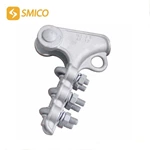Selection Of Bolt-type Strain Clamps When Using Insulated Wires
In densely populated, tree-filled, and polluted areas, we are increasingly using insulated wires to replace bare wires. Compared with bare wires, it has the advantages of high safety and reliability, reduced line loss, and less wire corrosion. When using insulated wires, we need to pay attention to the fact that since bolted type strain clamp is clamped on the outer diameter of the "wire" rather than the outer diameter of the "conductor", the dead end strain clamp model should be selected based on the outer diameter of the wire rather than the outer diameter of the conductor. For example, KLGYJ-150/8 steel core reinforced cross-linked polyethylene insulated overhead cable is used in power lines. It is calculated that its conductor outer diameter is 15.30mm, plus its insulation thickness of 3.4mm and conductor shielding thickness of 0.5mm, it can be known that its conductor outer diameter is 23.1 mm. According to the above table, the bolted dead end clamp that should be used is NLL-5. If we select the equipment wire clamp based on the conductor outer diameter of 15.30mm at this time, the selected equipment wire clamp will never be used.
In addition, when installing the tension clamp, we must tighten the screws evenly, requiring that there is no increase in wire stress at the contact surface between the wire and the original metal after installation, so as to prevent damage to the wire caused by breeze vibration or other wire oscillation and ensure that the gripping force of the tension clamp on the wire is not less than 95% of the wire breaking force.

